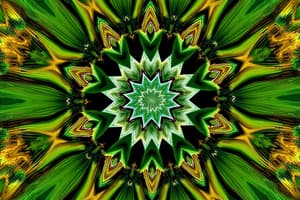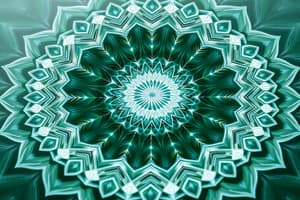Podcast
Questions and Answers
What is a primary characteristic of patterns as mentioned?
What is a primary characteristic of patterns as mentioned?
- They can only be sequential.
- They are found in various forms such as spatial and temporal. (correct)
- They are always man-made.
- They are irregular and unpredictable.
Which of the following best describes regularity in the context of mathematics?
Which of the following best describes regularity in the context of mathematics?
- The occurrence of similar events under identical circumstances. (correct)
- A sporadic phenomenon with no logical explanation.
- A deviation from expected patterns in nature.
- A unique configuration that cannot be replicated.
In what way is mathematics expressed and represented?
In what way is mathematics expressed and represented?
- Only through numerical symbols.
- Largely through graphical representations alone.
- Through a combination of symbols, expressions, and concepts. (correct)
- Exclusively through verbal communication.
What role does mathematics play in discussing patterns in nature?
What role does mathematics play in discussing patterns in nature?
Which of the following is NOT an aspect students should be able to articulate about mathematics?
Which of the following is NOT an aspect students should be able to articulate about mathematics?
What is one function of patterns in nature according to the provided material?
What is one function of patterns in nature according to the provided material?
Why is recognizing patterns in nature considered a natural extension of mathematics?
Why is recognizing patterns in nature considered a natural extension of mathematics?
Which of the following is an example of regularity in a calendar system?
Which of the following is an example of regularity in a calendar system?
What defines a pattern in mathematics according to the content?
What defines a pattern in mathematics according to the content?
Which of the following is an example of a number pattern mentioned?
Which of the following is an example of a number pattern mentioned?
What characteristic of patterns is specifically highlighted in their relation to nature?
What characteristic of patterns is specifically highlighted in their relation to nature?
Which of the following describes a spiral pattern?
Which of the following describes a spiral pattern?
Which pattern is characterized by regular curves or winding in water courses?
Which pattern is characterized by regular curves or winding in water courses?
What distinguishes a tessellation pattern from other types of patterns?
What distinguishes a tessellation pattern from other types of patterns?
What is indicated by the term 'waves or riffles' in relation to patterns?
What is indicated by the term 'waves or riffles' in relation to patterns?
Which option best describes symmetry as a type of pattern?
Which option best describes symmetry as a type of pattern?
What characterizes a fractal?
What characterizes a fractal?
Which of the following best describes a finite sequence?
Which of the following best describes a finite sequence?
In which field is mathematics primarily used for navigation and prediction?
In which field is mathematics primarily used for navigation and prediction?
Which of the following examples primarily utilizes arithmetic sequences?
Which of the following examples primarily utilizes arithmetic sequences?
Which of the following best represents an infinite sequence?
Which of the following best represents an infinite sequence?
What is the primary focus of fractals in mathematics?
What is the primary focus of fractals in mathematics?
Which application of mathematics is most relevant to robotics?
Which application of mathematics is most relevant to robotics?
Which of the following choices describes Stripes and Spots?
Which of the following choices describes Stripes and Spots?
What is the common difference of the sequence 8, 11, 14, 17, ...?
What is the common difference of the sequence 8, 11, 14, 17, ...?
Using the formula $a_n = a_1 + (n - 1) d$, what would be a6 for the sequence where $a_1 = 3$ and $d = 3$?
Using the formula $a_n = a_1 + (n - 1) d$, what would be a6 for the sequence where $a_1 = 3$ and $d = 3$?
What is the 20th term, $a_{20}$, in the sequence starting with 8 and a common difference of 3?
What is the 20th term, $a_{20}$, in the sequence starting with 8 and a common difference of 3?
In the sequence 7, 2, -3, -8, ... what is the value of $a_6$?
In the sequence 7, 2, -3, -8, ... what is the value of $a_6$?
What is the definition of a 'series' in mathematics as presented?
What is the definition of a 'series' in mathematics as presented?
What is the golden ratio approximately equal to?
What is the golden ratio approximately equal to?
For the sequence defined by $a_1 = 7$ and $d = -5$, how do you calculate $a_{10}$?
For the sequence defined by $a_1 = 7$ and $d = -5$, how do you calculate $a_{10}$?
What does the term 'terms' refer to in the context of sequences?
What does the term 'terms' refer to in the context of sequences?
Flashcards
What are patterns?
What are patterns?
Repeated designs or sequences in various forms (sequential, spatial, temporal, linguistic).
What is regularity?
What is regularity?
The repetition of events under consistent conditions.
What is symmetry in nature?
What is symmetry in nature?
Harmonious proportions and balance in design.
What are spirals?
What are spirals?
Signup and view all the flashcards
What are meanders?
What are meanders?
Signup and view all the flashcards
What are waves?
What are waves?
Signup and view all the flashcards
What are foams and bubbles?
What are foams and bubbles?
Signup and view all the flashcards
What are tessellations?
What are tessellations?
Signup and view all the flashcards
What are fractures or cracks?
What are fractures or cracks?
Signup and view all the flashcards
What are stripes and spots?
What are stripes and spots?
Signup and view all the flashcards
What are fractals?
What are fractals?
Signup and view all the flashcards
What is the Fibonacci Sequence?
What is the Fibonacci Sequence?
Signup and view all the flashcards
What is a finite sequence?
What is a finite sequence?
Signup and view all the flashcards
What is an infinite sequence?
What is an infinite sequence?
Signup and view all the flashcards
What is an arithmetic sequence?
What is an arithmetic sequence?
Signup and view all the flashcards
What is the golden ratio?
What is the golden ratio?
Signup and view all the flashcards
Formula for nth term of arithmetic sequence
Formula for nth term of arithmetic sequence
Signup and view all the flashcards
Study Notes
Patterns in Nature and Mathematics
- Mathematics is a tool for understanding patterns in nature and the environment.
- Patterns are repeated designs or sequences; they can be sequential, spatial, temporal, or linguistic.
- Regularity refers to the repetition of events under the same circumstances.
- Patterns in nature exhibit visible regularities.
Types of Patterns in Nature
- Symmetry: Harmonious proportions and balance.
- Spirals: Curves emanating from a point, moving outward as they revolve.
- Meanders: A series of regular sinuous curves, as seen in rivers.
- Waves/Riffles: Disturbances transferring energy through matter or space.
- Foams/Bubbles: Substances trapping pockets of gas in liquids or solids.
- Tessellations: Repeated geometric shapes covering a plane without overlaps or gaps.
- Fractures/Cracks: Separations of an object into pieces due to stress.
- Stripes and Spots: Series of bands or spots, often of the same width and color.
- Fractals: Infinitely complex self-similar patterns at different scales.
Uses of Mathematics in Different Fields
- Technology: Navigation and prediction.
- Engineering: Construction and robotics.
- Media: Music, movies, and elections.
- Medicine and Health: Pharmacy, surgery, and diagnostics (e.g., MRI).
- Finance and Business: Banking, gambling, and data analysis. Many more including supply chains, insurance, loans, fraud detection, and pricing strategies are also impacted by mathematics.
Number Patterns and Sequences
- Fibonacci Sequence: Starts with 0 and 1; each subsequent number is the sum of the previous two (0, 1, 1, 2, 3, 5, 8...). Appears in nature (e.g., petal arrangements in flowers).
- Finite Sequence: Has a first and last term.
- Infinite Sequence: Has a first term but no last term.
- Arithmetic Sequence: Each term is obtained by adding a constant difference (d) to the previous term. The formula to find the nth term is: an = a1 + (n – 1)d, where 'an' is the nth term, 'a1' is the first term, 'n' is the number of terms, and 'd' is the common difference.
Golden Ratio
- Denoted by the Greek letter Phi (φ), approximately 1.6180339887...
- Found in various aspects of nature and art.
Studying That Suits You
Use AI to generate personalized quizzes and flashcards to suit your learning preferences.




